by Teresa Byington, Consulting Rosarian, Indianapolis Rose Society
A post from Teresa Byington’s “The Garden Diary”
Those destructive, nasty, no good, horrible Japanese beetles are here, so we might as well talk about them.
THEIR HISTORY
The Japanese beetle is native to Japan. These little nuisances were first discovered in the United States around 1916 near Riverton, NJ in a nursery. It is thought that beetle larvae got into the US in a shipment of iris bulbs before inspections of imported goods entering the country began in 1912.
It is not just roses they love … they feed on around 200 species of plants that you stay on the proper intervals for subsequent applications.
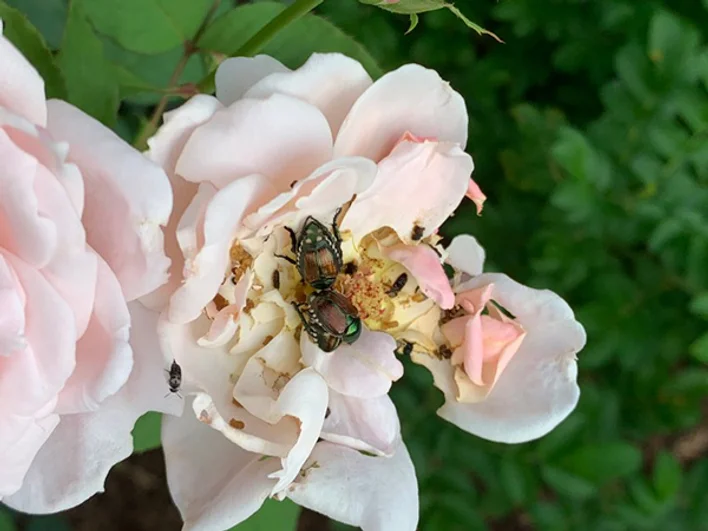
My beautiful Quietness rose is one of their favorites. This happens so quickly!
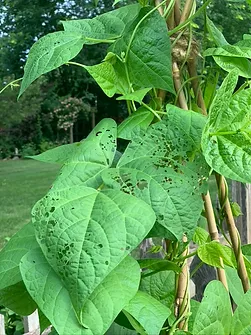
I used to read that JBs were all east of the Mississippi, however, they are now being spotted in many other places around the country. I suspect they are still hitchhiking in plant containers! So no one will be safe before long. Now if only we could get them to “shelter in place” so we could eradicate them. LEFT: Just look at my beautiful pole beans.
MY WORLD
Japanese Beetles are a real problem in my area, especially last year. I first saw them on June 21 and I was still seeing them in late August. Mark Nolen, past president of the Indianapolis Rose Society, who has been growing for 50 years and grows over 300 roses, counted them last year and his total count was over 5,000. Let’s hope that record is not broken this year!
Are you grossed out yet?
One of the very few upsides to drought is that it can interrupt their life cycle. After a particularly serious drought a few years ago, we had several years with few to no Japanese Beetles. I visualized the larvae being killed in the parched earth. Do you think differently of me now?
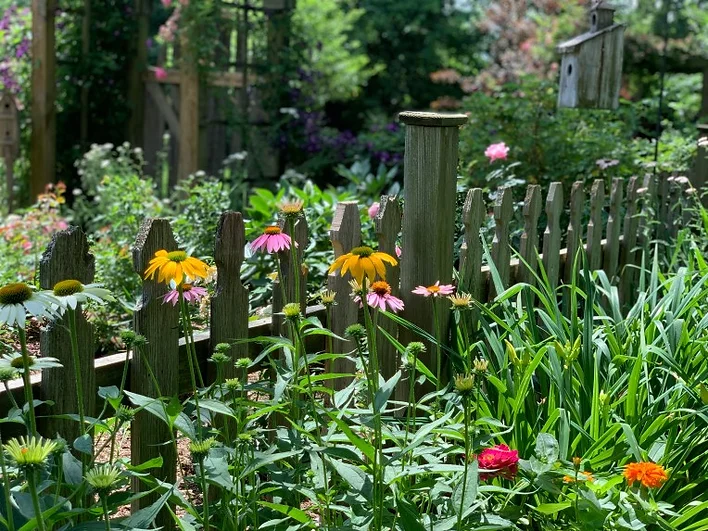
WHAT TO DO???
SPRAYS
I have chosen not to spray them as the spray kills more than the targeted pest and we want to protect the good guys. I did try sprays many years ago but saw little help. Your call on that one. As always read labels carefully and protect yourself!
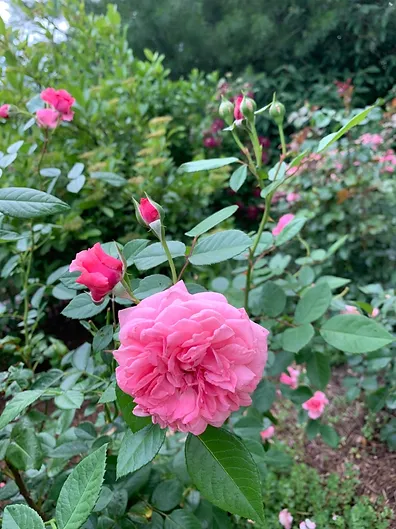
HANDPICKING
The best method of control I’ve found is “handpicking.” When I say handpicking I mean tapping the area where the beetles are on the shrub and watch them fall into a bucket of soapy water. When startled, it is their natural response to drop and get to the ground as fast as they can (procreation and all that) – so in the water they go. The recommendation is to start this daily regimen as soon as they arrive and get them off the plants as soon as possible. The damage and droppings they leave behind contain their pheromone – a call to all their friends to come! So, the more you have the more you get!! It is best to even cut away and destroy the damaged area on the shrub. If you’re in a stressful season- squishing them works too. However… I have heard that the squishing process releases the pheromone that calls in the JB troops. Your call. No judgment here! ABOVE: Zaide and her neighbors have been attached but not all blooms have been destroyed!

I know. This is gross and you’d probably rather not see this. Last year I featured a better looking picture taken when I first started the bucket, not after all day. That article also included some great pictures of lilies which we probably won’t have this year due to the late freeze. Sad. So, maybe you should head over to last year’s article for a quick peek HERE…. BLOOMS, BUGS and HEAT.
Beetle Traps
There is great debate about using beetle traps. They do work and beetles by the thousands have found their way to the beetle traps my husband “loves” to use. He places them at the edge of property and is gleefully happy when the trap is full. Some say it helps control and some say it brings more in. Your call. We buy them at Lowes… good luck. Note: Since our beetle population is down a bit this year, we have not put out the traps. Mr. G agreed to wait and see how the season goes.
GRUB CONTROL
Many are trying biological means to control them in the larvae stage. I have a very large garden with a good size lawn and none of the biologicals out today (primarily nematodes and milky spore fungus) seem worth the effort. However, though it takes time, do some research – it might be worth your effort.
MOLES
Another unwanted pest in our garden is moles but they do eat grubs … so nature does have it’s ways. However, moles digging up your garden is a whole other horrible problem.

ABOVE: My new dreamy Dreamland geranium
Geraniums
Research is being done with Geranium petals as they cause temporary paralysis in Japanese Beetles – making them more vulnerable to their enemies. It’s a start and I bought 3 more hardy geraniums – just in case. The variety is ‘Dreamland’ and it’s very pretty. I’ve always loved geraniums – this just takes that love to the next level.
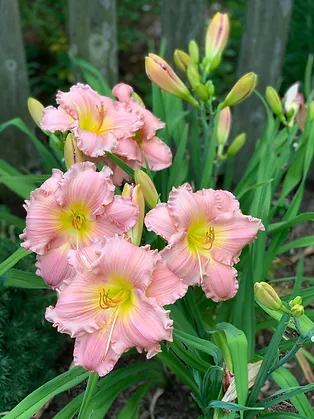
YOU
If you have any tips and tricks that are working for you, please leave a comment so we can all benefit!
BLOOM THYME…
Finally, it’s time for something pretty! With all the talk about the JBs you are probably wondering if any blooms have escaped. Oddly enough they don’t love every flower… but we do! RIGHT: I’m just crazy about daylilies.
ABOVE: Photos by Teresa Byington




























































